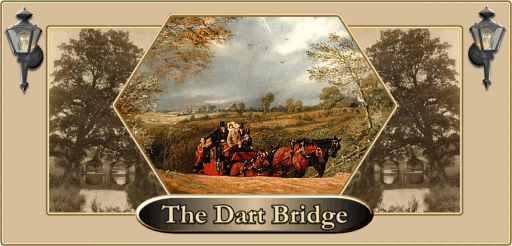
The Dart Bridge at Buckfast has the distinction today of being the last crossing place of the river Dart before it leaves the boundary of the National Park. That there has been a bridge here for centuries is not surprising due to the proximity of Buckfast Abbey. One of the earliest documentary records of a bridge being here was from the Assize Rolls of 1356 where ‘Dertebrygg’ is mentioned. Hemery (1982, p.74) notes how in 1374, Abbot Symons, obtained from the Bishop of Exeter an indulgence for those who would take part in the ‘building or repairing of the Buckfast Bridge. In 1406 a bequest of 12d was made for the maintenance of the bridge and in 1599 The Sessions agreed to spend the princely sum of £21 to repair the structure. In 1607 the bridge was once again in decay and it seems as this was the destiny of the structure, repair and then decay. Henderson and Jervoise (1938, p.34) describe how the bridge is built of local stone which is unusual for Dartmoor bridges are normally constructed with granite. They also note how the earliest bridge consisted of four arches and how in 1809 the roadway was 8½ feet wide and described as being, “narrow and inconvenient”. By 1926 the structure had been widened to 19 feet which around the 1930s had stretched to 40 feet with the length of the structure spanning 50 feet. In the July of 1974 a 44 year old man was killed when he fell off the new bridge whilst working on the structure. The present day bridge was opened in 1974 and still carries the many visitors over the river Dart as they visit Buckfast Abbey.
The narrowness of the bridge in the early 1800s is reflected in the following report that appeared in The Times on Saturday, June the 23rd 1827;
“On Saturday morning last, as the mail coach from Exeter to Plymouth was crossing Dart Bridge, about three miles from Ashburton, the leaders took fright at a heap of stones which had been laid down for repairing the road, and suddenly crossed to the opposite side. In consequence of which the coach received so great a jerk, that the driver was thrown from the box and fell among the horses. A man, the only outside passenger, was also thrown off, but he received no other injury than a few slight bruises. The coachman was, however, not so fortunate, for the vehicle passed over his body from the groin to the shoulder, and bruised him severely, but without breaking any bones. The guard at the moment of the accident got down to assist the coachman, who was, after a few minutes, enabled to rise and follow the coach. In the mean time the horses proceeded at a rapid pace, and in going through Buckfastleigh, they passed so close to the houses that the lamp and handle of the door were torn off, and the splinter bar and one of the traces were broken. Upon this a gentleman, who was the only inside passenger, became alarmed, and looked out to ascertain what was the matter. Seeing that the coachman was not in the box, he got out of the coach, and having succeeded in reaching the ground safely, he laid hold of the reins and stopped the horses without further mischief being done. On reaching Buckfastleigh the coachman was put to bed, and medical aid being procured, the necessary remedies were applied, and we have much satisfaction in adding, that it is expected he will be able to resume his duties in a few days. His escape was indeed miraculous.
We understand that he is a steady driver, and that no blame can attach to him on this occasion. The splinter bar and trace having been replaced, the guard drove the coach to Plymouth“.
Who says you can only find the ‘Wild West’ in America, the West of England can also have heroes that save stage coaches, ’twas just a shame there were no Indians around.
Bibliography.
Hemery, E. 1982 Historic Dart, David & Charles, Newton Abbot.
Henderson, C. & Jervoise, E. 1938 Old Devon Bridges, Wheaton & Co, Exeter.
 Legendary Dartmoor The many aspects past and present of Dartmoor
Legendary Dartmoor The many aspects past and present of Dartmoor
